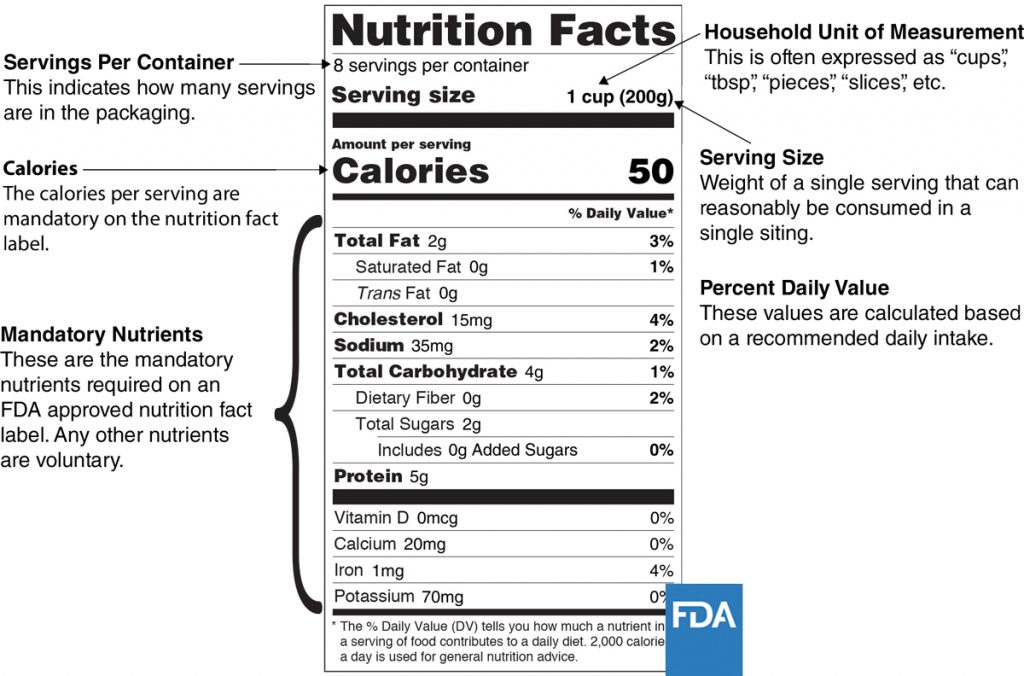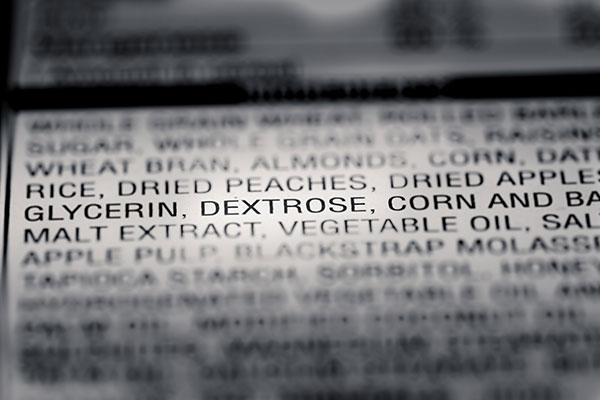A FDA-approved nutrition fact label is designed to reflect the most up-to-date recommendations from the Food and Drug Administration regarding the nutrition facts of certain foods. The mandated contents of the label are routinely updated, and makes it easier and more accessible for consumers to understand the nutritional value of the food they are buying and make healthier and more informed choices about their diets. FDA nutrition fact labels appear on the majority of food packages sold around the country.
It can be challenging to ensure that you as a food and beverage manufacturer are remaining compliant and keeping up with the latest guidelines from the FDA. Below outlines what should be included on an FDA-approved nutrition label, and what each category means (serving sizes, percentage daily values, etc.).
What should be Included?

On an FDA-approved food label, there are certain nutrients that must be included. These requirements are as follows:
- Calories
- Fat
- Trans
- Saturated
- Cholesterol
- Sodium
- Carbohydrates
- Fiber
- Sugars
- Added Sugars
- Protein
- Vitamin D
- Potassium
- Calcium
- Iron
Not only is it regulated by law that all these items be shown on the nutrition label, but it is vital to the consumer as they attempt to become more informed about their food choices.
Serving Sizes Explained
In addition to the mandatory nutrients, nutrition fact labels must also include servings per container as well as serving size and household unit of measurement. There are three categories here that are important to be aware of:
Serving sizes are one of the most important measurements to take note of on the FDA-approved nutrition label. The serving size is a measurement of food that is appropriate for consumption as dictated by the nutrition guidelines.
Serving size per container – The total number of servings in the entire food package or container.
Serving size in weight – Details the portions of the serving
Household equivalent (of serving size) – Refers to cup, tablespoon (tbsp), teaspoon (tsp), piece, slice, fraction (e.g., 1/4 pizza), ounce (oz), fluid ounce (fl oz), or other common household equipment used to package food products (e.g., jar, tray). (Source: FDA)
Further, serving size is determined by the category of food. This also helps consumers compare brands to see which option is healthier.
For instance, if Brand A of yogurt had 90 calories per one cup, but brand B had 200 calories per one cup, it would be very easy for the consumer to discern which was healthier simply by looking at the serving size metric. However, if Brand A had 90 calories per serving, and the serving size equivalent to a half cup, one full cup would be double – 180 calories. This is why it is important to note the serving size when comparing food options as well.
It’s also important to note the weights of food and how they are represented, which may vary and impact what a serving size looks like. In some instances, the food product is measured in grams, while in other instances it may be measured in fluid ounces. This is when it is important to be aware of servings per container, which refers to the total amount of servings included in a packaged food product.
Rounding Rules and % Daily Values
In order to ensure consistency, FDA created rounding rules that provide a best estimate for an ingredient or food product. An example of this can be found below, in regard to calories:
The Daily Value (DV) % is calculated for Fats, Cholesterol, Sodium, Carbohydrates, Fiber, Vitamins and Minerals. Every nutrient/category has its own recommended DV chart. What can be confusing is that the daily value percentages do not add up to 100%. Rather, they are to depict the amount consumed by a specific category of your daily recommended total.
For instance, if you consume a nutrition bar whose protein content makes up 60% of your daily value of protein, that means you have hit 60% completion of your goal for the day.
Ingredients Lists and Allergens

The majority of food products are required to have an ingredients list on the packaging. There are some exceptions – butter is one example – but there will likely need to be a comprehensive list of ingredients on the packaged food that is being sold. This is extremely important, as it informs consumers exactly what they are eating, should they be trying to eliminate anything from their diet for health reasons or, more importantly, be allergic to something specific. Additionally, ingredients lists are in descending order by weight in the food product.
Fortunately, allergen warnings on food labels are required by law. To protect consumers with either slight or severe food allergies or sensitivities, the FDA has developed regulations that require companies to create labels to list ingredients on all food and beverages. For certain foods that were grown or manufactured in a place where they may have been exposed to a popular allergen (i.e. peanuts, nuts, soy), it must be clearly displayed on the label that potential cross-contamination occurred. Cross-contamination of allergens needed to be stated as a “may contain,” to cover all bases.
In 2004, the Food Allergen Labeling and Consumer Protection Act (FALCPA) was signed into law by congress. This law identified the below foods as major food allergens that must be noted when creating labels for food products:
- Milk
- Eggs
- Fish
- Shellfish
- Tree nuts
- Peanuts
- Wheat
- Soybeans
Creating an FDA-approved nutrition fact label will not only help your company remain compliant with the most up-to-date guidelines, but will instill confidence in your customers. MenuSano helps you consistently achieve these standards.
Food and Beverage manufacturers and Food Processors’ responsibilities are continuously evolving with the introduction of new ingredients, trends, and methods of creating and serving food to customers. That said, it is extremely important that foodservice providers remain compliant and provide accurate nutrition information to their customers. MenuSano is a solution that can help you solve this problem.
MenuSano nutrition analysis software is an online nutrition calculator that provides an affordable, flexible, user-friendly solution that your business can use to calculate nutritional content of all of your current and future products. Not only that, but it was designed to be compliant with the standards set by Canada, the USA, and the UK governments and is continuously updated to maintain its compliant status.
MenuSano is a highly effective tool because:
- Its design is flexible, user-friendly and convenient
- The information is accurate
- The database of ingredients is extensive
- Has recipe experimentation capabilities
- Compliant with FDA and CFIA regulations
- Consistently updated to keep up to code with the above regulations



















